In this post I discuss about poison mushroom, its appearance and resemblance to those edible mushroom types. (you can read our post regarding edible mushrooms by clicking here)
Mycetism refers to harmful effect of mushroom poisoning. There are many kinds of symptoms that occur with the victim of mushroom poisoning this include gastrointestinal discomfort. Often times mushroom poisoning can be fatal. Mistaken identity of poison mushrooms in the wild as is one of the common reason of mushroom poisoning. Some people may have confused the toxic mushroom to be of those types that can be ingested. Some folklore describes inedible mushrooms as bright colored which insects and animals avoid. In addition, this type of mushrooms reacts to silver contamination. It is also described that poisonous mushrooms tastes awfully bad and turns red when cooked.
Here’s the poison mushroom list
1) Amanita Muscaria or Fly Agaric

Amanita Muscaria or Fly Agaric mushroom (Wikipeda)Fly Agaric or fly Amanita (Amanita Muscaria) mushrooms, is a psychoactive and poisonous fungus found in pine plantations. Though known as poisonous, fatalities are very rare, for those who have eaten these species. Amanita muscaria, is famous for its hallucinogenic properties. These species are consumed in some parts of Europe, North America and Asia after leaching or parboil in water to remove the toxic substance and odd tastes.
Amanita muscaria var. Guessowii mushroom
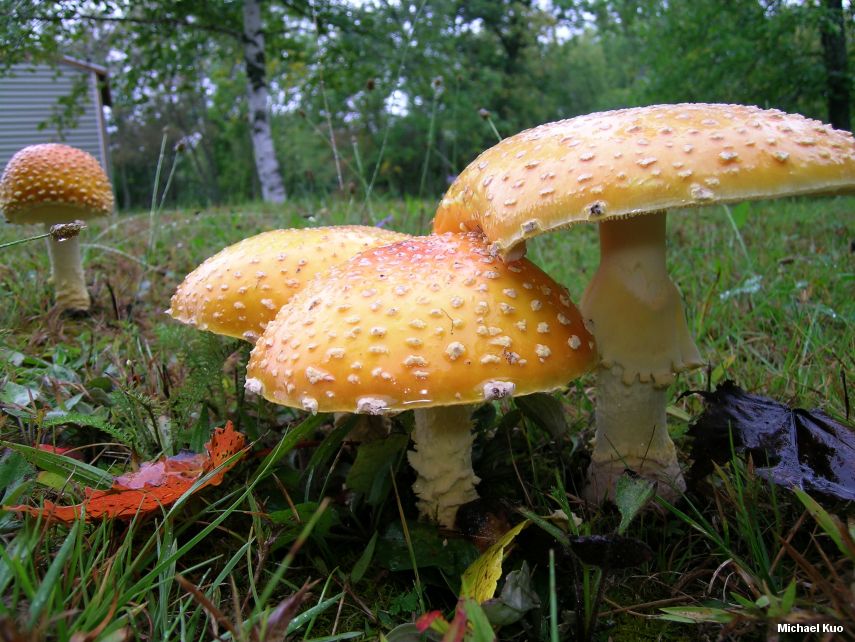
Amanita Muscaria var. Guessowii (Wikipedia)
Amanita muscaria var. guessowii, has yellow or sometimes orange cap, commonly found in North America.
Amanita Regalis or Royal Agaric
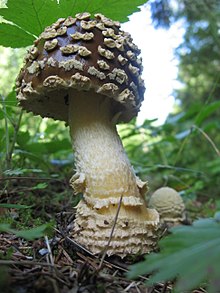
Royal Agaric mushroom (Amanita Regalis) (Wikipedia)
Royal agaric, King of Swecen Amanita or common name Amanita Regalis, is found in North America, Europe, but distribution of these species is not allowed in Alaska. Symptoms for A. ragalis poisoning are nausea, vomiting, hallucinations, discomfort and gastrointestinal, confusion and sometimes loss of consciousness and extreme sweating. It may not cause fatality but maybe can cause damage to some internal organs.
Amanita muscaria Formosa

Amanita Muscaria var. Formosa Sensu (Wikipedia)
2) Common Ink Cap mushroom (Coprinopsis atramentaria)

Common Ink cap mushroom (Coprinosis atramentaria)(Wikipedia)
Common ink cap mushroom or the Coprinosis atramentaria or inky cap is actually an edible mushroom, but sometimes it is poisonous. It is usually found growing in Europe and North America. After the rain during spring and autumn season, groups of Inky cap mushrooms appear in lawns or grassy lot areas. Alcohol should not be consumed when eating these inky cap mushroom because it can cause a much toxic effect, called tippler’s bane. The cyclopropylglutamine compound or the coprine, is found on Coprinopss atramentaria fungus, it is highly toxic especially if ingested with alcohol.
3) False Morel mushrooms (Gyromitra esculenta)
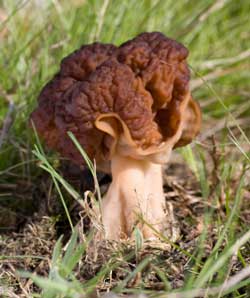
False Morel mushroom (Gyromitra esculenta) (Wikipedia)
The False morel mushroom or Gyromitra esculenta, commonly found in Europe and North America, this type of poisonous mushroom grows in sandy soil in the woods during the Spring and Summer season. Gyromitra esculenta are a famous delicacy in Scandinavia, North America, Europe and districts of Spain and France borders, although it is known as poisonous and could cause death to consumers. In Spain it’s prohibited to sell false morel mushroom commercially, but it is allowed in Finland provided that the preparer has “warning signs and instructions on correct preparation”. As odd as it may seem, this mushroom is popular in Finnish cuisine. In some studies, parboiling of false morel cannot totally remove the toxins and consumers taking risks to eat false morel mushroom often causes concern.
4) Early Morel or Wrinkled thimble-cap mushroom (Verpa bohemica)

Early False morel (Verpa bohemica) (Wikipedia)
Verpa bohemica, Early false morel, Early morel or wrinkled thimble-cap morel are species known as false morels. It is considered edible mushroom, but there are studies and reports of poisoning among the consumers of these false morel mushroom.
5) Saffron milk-cap, Red pine mushrooms or Lactarius deliciosus
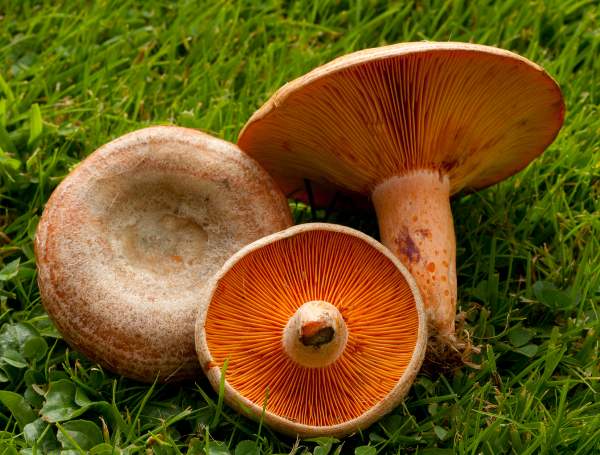
Saffron Milk-cap mushroom (Lactarius deliciosus) (Wikipedia)
Saffron milk-cap, Red pine mushroom or Lactarius deliciosus, are defined as best members of milk-cap genus Lactarius of Russulales family and is commonly found in North America and Europe. This type of mushroom was introduced to other countries and grows in pine plantations.
6) Jack-O-Lantern mushroom

Jack-O-Lantern mushroom (Omphalotus olearius) (Wikipedia)
Some people misidentifies Jack-o-lantern mushroom to its edible counterpart chanterelle mushrooms. Jack-o-lantern mushroom or Omphalotus olearius is most popular for its bioluminescent properties. After eating the poisonous Jack-o-lantern mushroom, the victim suffers severe cramps and numbness, vomiting and diarrhea.

Jack-o-lantern bioluminescent gills (Wikipedia)
Jack-o-lantern mushroom body doesn’t glow and the only parts that glow are its gills. The glowing is due to an enzyme substance called luciferase.
Western Jack-o-lantern mushroom (Omphalotus Olivascens)
-400.jpg)
Omphalotus Olivascens (Western Jack-o-lantern) (Wikipedia)
The Western Jack-o-lantern mushroom or Omphalotus Olivascens is an orange to brown colored mushroom and is commonly seen growing in California and Mexico.
7) Yellow Houseplant mushrooms (Leucocoprinus birnbaumii)

Yellow Houseplant mushrooms (Leucocoprinus birnbaumii) (Wikipedia)
The next type of poison mushroom Lepiota lutea fungus is now known as Leucocoprinus birnbaumii. It is also commonly referred to as yellow houseplant mushroom. This musrhooms grows on flower pots in lawns or gardens. Other names for this fungus are flower pot parasol and plant pot dapperling.
![]() False Chanterelle or Hygrophoropsis aurantiaca
False Chanterelle or Hygrophoropsis aurantiaca
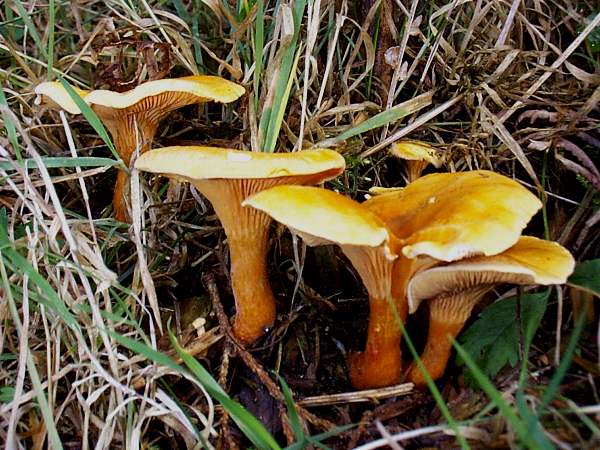
False Chanterelle (Hygrophoropsis aurantiaca) (Wikipedia)
The false chanterelle is an orange funnel-shaped mushroom and has been misidentified with the true chanterelle. False chanterelle or Hygrophoropsis aurantiaca are not edible and can be toxic for human consumption.
9) Common Earthball or Scleroderma citrinum
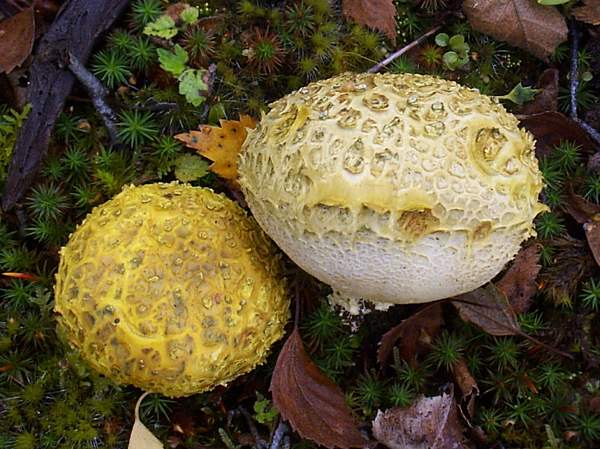
Scleroderma Citrinum or Common Earthball mushroom (Wikipedia)
Common Earthball, pigskin poison puffball or Scleroderma citrinum mushroom, are popular Earthball mushroom seen growing in United Kingdom. Most of the time this mushrooms can be found growing in the woods, meadows or grassy areas in the autumn and winter season. It has similarity with the edible puffballs, but eartballs are smaller than puffballs, and edible puffballs have single opening on top of its cap where spores are dispersed. Also, the spores of earth balls come out when earthball break-up.
10) Boletus Satanas or Devil’s Bolete

Boletus Satanas or Devil’s Bolete mushroom (Wikipedia)
Satan’s mushroom, Devil’s bolete or Boletus Satanas can be commonly seen growing in chalky soil, in the woods, in warm regions of Europe and North America.
Boletus Legaliae , related to Boletus Satanas

Boletus Legaliae (Related to Boletus Satanas) (Wikipedia)
11) Podostroma Cornu-damae mushroom

Podostroma Comu-damae Fungus (Wikipedia)
The Podostroma cornu-damae fungus is from species of Hypocreaceae genus. It is known as highly poisonous and reports have been made of several fatalities in Japan because of trichothecene mycotoxins substance found in these fungus.
12) Violet Coral fungus (Clavaria Zollingen)

Violet Coral fungus (Clavaria Zollingen) (Wikipedia)
Magenta coral mushroom, Violet coral or Clavaria zollingen fungus, produces purple basidiocarps, tubular bodies that grows in clusters, commonly seen growing on woods and leaves litters.
13) Crown Coral Fungus (Artomyces Pyxidatus)

Crown Coral fungus (Artomyces pyxidatus) (Wikipedia)
Crown coral mushroom, Crown-tipped coral mushroom or Artomyces pyxidatus are considered edible, when properly prepared and cooked, but some people experienced gastrointestinal discomfort right after eating and consuming this mushroom. It has peppery taste when raw, but disappears when cooked.
14) Man on Horseback mushroom or Yellow Knight Mushroom

Man on Horseback mushroom (Tricholoma equestre) (Wikipedia)
Tricholoma equestre mushroom or commonly called Man on horseback or yellow knight mushroom is formerly an edible mushroom. It is found very hazardous for human consumption. It is called Grunling in German language, gaska zielonka in Polish, Canarii in French. This mushroom has been known as delicacy in many parts of the world. The tasty and delicious T.equestre mushroom is now known as poisonous. Reports have revealed several cases of poisoning after consumption of Tricholoma equestre mushroom.
15) Lethal Webcaps or Deadly Webcaps mushrooms
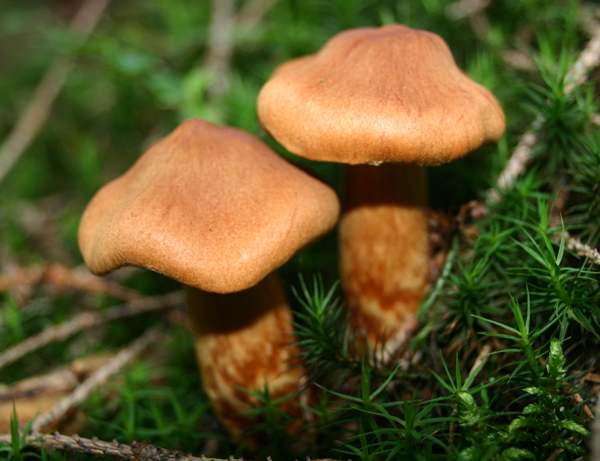
Lethal Webcaps mushrooms (Wikipedia)
Deadly webcaps (Cortinarius rubellus or former C. Speciosissimus) and the Fool’s webcap (Cortinarius Orellanus) are the most two species known as deadly poisonous mushrooms in the world.
16) Agarius Deserticola mushroom
Agarius deserticola mushroom also called Gastroid agaricus , is species of Agaricaceae family found only in Southwestern and western North America. Edibility of Gastroid agaricus is not known. In some reports, they said it is edible when picked young, have pleasant aroma and mild taste when cooked. But some people said that it’s hazardous to human consumption, and therefore it shouldn’t be eaten.
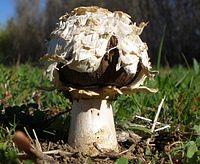
Agarius Deserticola mushroom or Gastroid agarius (Wikipedia)
17) Psilocybe mushroom or magic mushrooms

Psilocybe Cyanofriscosa mushrooms (Wikipedia)
The genuses of small mushrooms also known as, “magic mushrooms” are commonly seen growing in many parts of the world. These types of mushrooms are also known for its psychedelic or hallucinogenic substances. The Psilocin and Psilocybin are substances that are responsible for poisoning. These substances also cause psychoactive effects to humans.
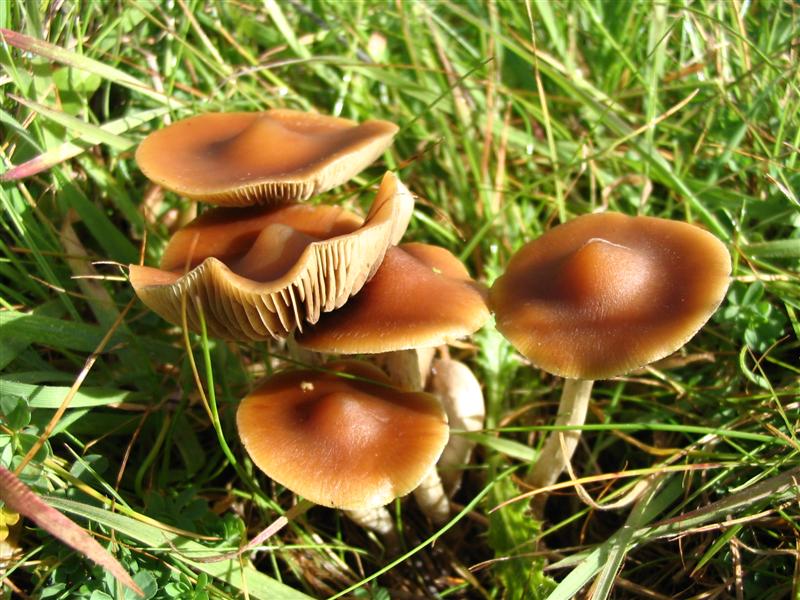
Psilocybe Subaeruginosa mushrooms (Wikipedia)
Psilocybe subaeruginosa mushrooms, commonly found in Australia, contains the main active compounds of psilocybin and psilocin
18) Wavy Caps or Psilocybe cyanescens

Wavy Caps (Psilocybe cyanescens) (Wikipedia)
The Psilocybe cyanescens also called “Wavy cap mushrooms” is a potentially psychedelic mushroom. It contains active substances of psilocybin and psilocin.
19) Gomphus floccosus mushrooms
Gomphus floccosus mushrooms are usually found in Eastern Asia. The other names of Gomphus Floccosus mushrooms are wooly gomphus, wooly chanterelle and or shaggy and scaly. This odd type of mushroom has its unique appearance the shape is often compared to a trumpet or a vase. Consuming this mushroom can cause nausea and vomiting. A substance called α-tetradecylcitric acid could be the responsible toxin.

Gomphus floccosus (Shaggy or Wooly Chanterelle mushroom) (Wikipedia)
20) Poison pie or Fairy Cakes mushroom (Hebeloma crustuliniforme)
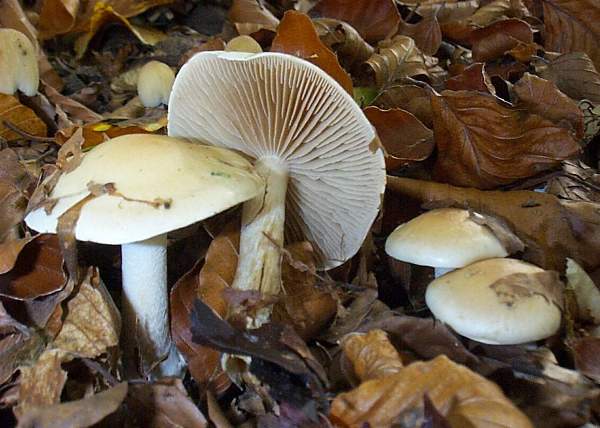
Hebeloma crustuliniforme (Poison Pie or Fairy Cakes mushrooms) (Wikipedia)
Poison pie mushroom also called “Fairy cake mushrooms is a genus of Hebeloma crustiliniforme commonly found in Europe and was introduced in Australia. It is well- known for its moderate poisonous properties.
